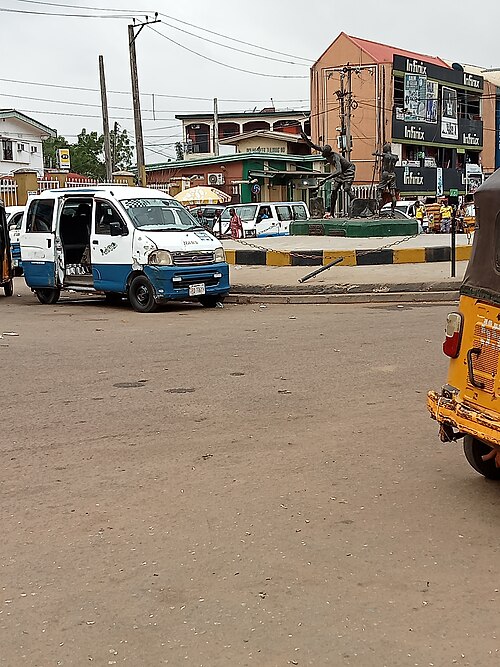Tragedy in Awka: Young Masquerader Killed in Broad Daylight During ‘Imo Awka’ Festival
On what was supposed to be a joyful day of tradition, cultural pride, and community gathering, sorrow blanketed Awka as a tragic accident turned the annual Imo Awka masquerade festival into a scene of grief and horror. In the bustling heart of the Anambra State capital, a young boy dressed as a masquerade (mmanwu) was struck by a speeding Keke Napep (commercial tricycle), leaving his head crushed in a ghastly accident that left witnesses in tears and shock.
The incident occurred around 2:45 pm on Sunday afternoon along the busy Zik’s Avenue near the UNIZIK Junction, a hotspot for commercial activity and cultural processions. The masquerade festival, known for its vibrancy and historical relevance to the Awka people, was already in full swing when the horrifying event unfolded.
The Imo Awka festival is not just another event in Anambra’s calendar; it is a spiritual and ancestral celebration that symbolizes unity, blessings, and protection for the people of Awka. Rooted deeply in Igbo cosmology, the festival is marked by the appearance of hundreds of colorful masquerades who parade the streets, perform rituals, entertain onlookers, and pay homage to ancestral spirits.
YOU MAY READ
From Nightlife to Night Deals: The Untold Story of S3x Trade and Survival on Abakaliki Street, Awka
The term “Imo” loosely translates to “power” or “mystical force,” and the festival is historically tied to the deities that the Awka people believe safeguard their land. These masquerades, often donned by boys and men, are believed to be incarnations of spirits rather than mere performers. That belief makes the tragedy all the more spiritually disturbing for many elders in the community.
“It is unheard of,” said Chief Mathias Nwafor, a traditionalist and elder of the Awka council. “For a masquerade—especially a child masquerader—to die like that in the line of cultural duty… it is a bad omen.”
According to eyewitnesses, the small boy masquerader, believed to be about 17 years old, was attempting to cross the road with a group of older masqueraders while dancing and swinging his cane. He was wearing a red , green, brown , and white-themed raffia costume and had a carved wooden mask with cowries adorning its edges. In the chaos and excitement, the boy stepped ahead of the group and into the busy lane without seeing the approaching Keke Napep.
“I screamed,” said Chinenye Obi, a roadside fruit seller who watched the event unfold. “I saw the boy dancing… he didn’t see the Keke coming. The driver was trying to overtake another Keke and didn’t even slow down. Before we knew it, gbam! The Keke hit him, and his head slammed into the gutter edge. Blood just poured everywhere.”
The Keke reportedly came to a screeching halt seconds after the collision. But the damage had been done. The child lay motionless. His raffia costume soaked in blood. His mask split. The crowd gathered instantly, many shrieking in disbelief, while others tried to shield the body.
Emergency responders were nowhere in sight. It took nearly 40 minutes before officers from the Nigeria Police Force arrived to cordon off the area. The boy was declared dead at the scene.
As news of the boy’s death spread across Awka, shock and mourning replaced the celebratory tone of the festival. Several masquerade troupes returned to their base prematurely. Some elders called for an immediate suspension of further displays, citing spiritual implications.
“This is not a time to dance. “Our gods have been dishonored. A child has died carrying their image. Sacrifices must be made. The festival cannot continue as if nothing happened.”
Many Awka residents expressed their grief on social media. Photos of the lifeless boy in his blood-stained masquerade costume quickly went viral, with hashtags like #and #AwkaMasqueradeTragedy trending within hours.
This tragedy has reignited debates over public safety during cultural festivals in Nigeria, particularly in urban centers like Awka. While masquerade festivals are cherished and protected, critics argue that there’s little planning for crowd control, traffic management, or emergency response.
“There’s no reason a masquerade procession should be allowed to cross busy highways without traffic officers stationed at every junction,” said Dr. Agbata, This death was preventable.”
The tragedy also raises ethical questions about the involvement of minors in masquerade activities. While the tradition historically celebrates the strength and spiritual might of ancestors, it has evolved to include boys as young as six or seven being costumed and made to perform in public.
Some believe it’s a way of initiating them into cultural responsibility. Others now see it as a dangerous, unnecessary risk.
“I dressed like a masquerade at nine,” said Mr. Tony Udeze, a 40-year-old man who grew up in Awka. “It was a rite of passage. But things have changed. Our roads are busier. Life is faster. Maybe we need to rethink this.”
Sources close to the family say the Imo shrine will conduct a special cleansing ritual for the land and the spirit of the boy, believed to have merged with the deity upon donning the mask.
The Awka Youth Council has declared a day of mourning and announced plans to organize a candlelight procession in memory of the young masquerade.
As the city of Awka grapples with this loss, deeper questions linger: What does this tragedy say about our collective approach to preserving tradition? How do we modernize cultural expressions without compromising safety? Can spirituality and civic responsibility co-exist?
For now, the streets that once echoed with the chants of masquerades now carry the sobs of mourning. The chants of celebration have been replaced with questions, regrets, and a haunting silence.
The death of young Masquerade during the Imo Awka festival will go down as one of the most tragic cultural mishaps in recent memory in Anambra State. His loss is not only a blow to his family but to a tradition that has brought joy, unity, and spiritual strength to the people of Awka for centuries.
Whether his death becomes a turning point for reform or just another forgotten tragedy depends on how leaders, both traditional and governmental, respond in the coming days.
For now, all that remains is a blood-stained raffia costume, a broken mask, and the memory of a boy who just wanted to dance.





